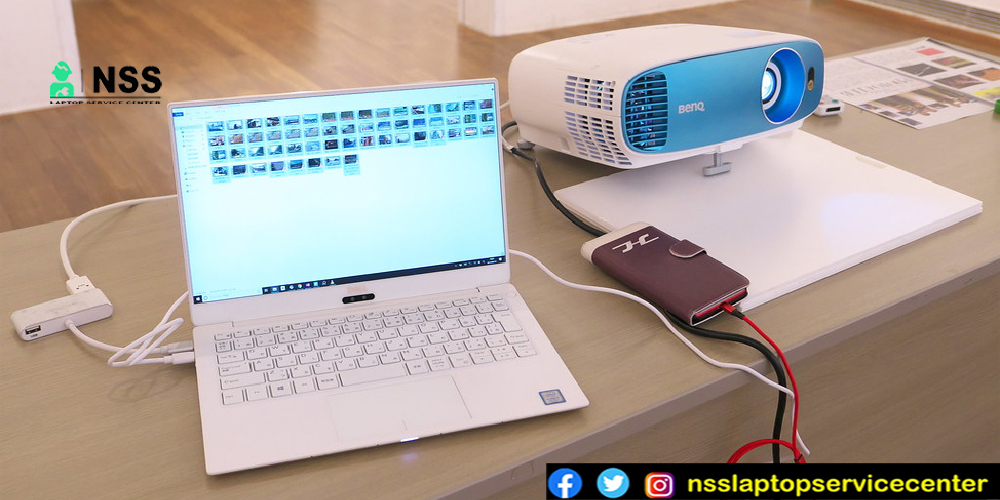
How To Connect Projector To Laptop:
Don't worry if you want to connect your laptop to a projector but don't know how to connect the Projector to the computer! You've arrived at the correct location! Follow the steps below to connect your laptop to the Projector fast and effortlessly!
What Is A Projector?
-
The meaning of projection varies depending on where it is used. In general, projection refers to something intended to be sent out or forwarded.
-
For example, a presentation is projected onto a white screen or surface in the auditorium for the students to view.
-
A projector is an optical output device that shows an image on a surface known as a projection screen.
-
It displays images on the projection screen by receiving input from a device such as a computer, laptop, or tablet.
-
In 1879, British photographer Eadweard Muybridge invented the first movie projector, called Zoopraxiscope.
-
A projector extends pictures and films and slides onto a surface for big gatherings such as classrooms and auditoriums.
What is a projector used for?
To better understand the issue, it is necessary first to grasp how a projector is used in everyday life.
We have listed 5 everyday uses for projectors below:
-
In schools, overhead projectors are often utilized for instructional reasons such as student presentations, discussion of slides, and announcements.
-
MNCs employ video projectors for conferences, meetings, and presentations.
-
Home theatre projectors are used to create a mini-home theatre for watching movies at home.
-
Film projectors are used to show movies in cinemas or theatres.
-
Finally, projectors are now utilized to display ads in airports, metro stations, and shopping malls.
Types of Projectors:
There are three types of projectors. These are as follows:-
-
Digital Light Processing (DLP)
-
Liquid Crystal Display (LCD)
-
Cathode Ray Tube (CRT)
Digital Light Processing projectors-
DLP is classified into two types: one-chip DLP and three-chip DLP. Texas Instruments produces these.
DLP projectors generate images using microscopically small mirrors, known as Digital Micromirror Devices (DMD). DLP projectors provide extremely crisp pictures.
Liquid Crystal Display projectors-
An LCD projector uses three liquid crystal displays to show pictures and movies. They are portable and smaller in size than CRTs. These are commonly used in business meetings, conferences, and seminars.
An LCD projector saves energy and provides high-quality pictures or movies.
Cathode Ray Tube or CRT projectors-
CRT projectors were widely utilized in the early days of projection. Each primary color, green, red, and blue, is represented by three tubes.
The primary drawbacks of CRT projectors were that they were heavy and oversized.
⇒ Also Read: How To Access Another Laptop From My Laptop
⇒ Also Read: How To Transfer Data From Mobile To Laptop
How to Connect Projector to Laptop Wireless in Windows 10:
Did you know how to connect a projector to a laptop?
We'll show you how to project your presentation, photos, or videos to a large projector screen from a Windows 10 device.
Requirements for connecting the Projector to a Windows 10 laptop for wireless display:
-
To use wireless projection, your laptop must have Windows 10 pre-installed.
-
If your Windows 10 desktop PC includes a Wi-Fi card, you may also use it for projection.
-
Hit Windows + K to ensure your PC or laptop supports wireless projection.
-
A connect option will appear, where you may determine whether your device supports wireless display.
-
A notice will appear at the bottom of the connect options if it does not support a wireless display.
-
The device we wish to connect, such as a projector, desktop monitor, or television, must support Miracast.
-
Most smart TVs include a wireless projection function that supports Miracast technology.
In some circumstances, you may need to install a screen share program, such as LG Screen Share.
However, if your Projector, television, or desktop display does not enable wireless connectivity.
Then, you must purchase a Microsoft wireless display dongle/adapter, which will be plugged into the device you intend to use for projection.
When purchasing the device, make sure that the dongle supports Miracast technology.
Steps to Connect Projector to Laptop Using Wi-Fi:
Assuming you have guaranteed that all of the prerequisites mentioned above have been met or taken care of, we are ready to connect.
-
Turn on both devices and your laptop's Wi-Fi.
-
Connect a wireless display dongle if your Projector, TV, or desktop monitor does not support wireless projection.
-
To enter the connect menu on your laptop, press Windows + K.
-
In the connect menu, you'll see the device (Projector, desktop monitor, or TV) you want to connect to the laptop.
-
When you connect the selected display device, you will notice that your laptop screen is shared with your device.

How to connect Projector to Laptop with HDMI:
HDMI is an abbreviation for high-definition multimedia interface. The primary benefit of utilizing an HDMI connection is that it can transmit video and audio information via a single wire.
HDMI cables are commonly used in appliances such as televisions, Blu-ray players, projectors, and PlayStations.
Steps to Connect Projector to Laptop Using HDMI:
Follow the instructions below to connect the Projector to the laptop via an HDMI cable:
Connect one end of your HDMI cable to the laptop's HDMI connector and the other to the Projector's HDMI port. Please confirm that the cable is correctly plugged in.
Devices should be turned on. Turn on both devices (Projector and laptop). Now, concurrently press Window + P. There are four alternatives available here. These are as follows:
-
PC screen only implies that the display output will only be seen on the primary device, such as a laptop or desktop.
-
Duplicate implies that the display on the projector screen will be the same as the display on your laptop screen.
-
Extend refers to the ability to shift items from one display to another.
-
The second screen only indicates that your display will be limited to the second screen, not the main one.
How to Connect Projector to Laptop using VGA Cable:
VGA is an abbreviation for Video Graphics Array. These are the standard connections for receiving video output. A VGA connection contains three rows of connectors, each with five pins.
It only provides video output; if you want audio output in addition to video, connect an audio cable from your laptop or desktop audio out port to the Projector's audio in port.
Steps for connecting the Projector to the laptop with a VGA cable:-
Make sure both devices are switched off at the start.
Connect one end of the VGA cable to the laptop's VGA port and the other to the Projector's VGA port.
Now, turn on both devices, the Projector and the laptop.
Because VGA cables only give image output and not audio, connect the audio output connection to the Projector or external speaker.
Now, on your laptop, hit the Window + P key and choose the appropriate projection from the four options: PC screen alone, duplicate, extend, or second screen only.
Also Read: How To Connect PS4 To Laptop
Also Read: What Can You Plug Into An HDMI Port On A Laptop
Conclusion:
You may also share the screen of your smartphone with the Projector. Using Chromecast or Miracast, Android phones may now broadcast a wireless signal to a projector, TV, or desktop PC.
Frequently Asked Questions
Popular Services
- MacBook Battery Replacement Cost
- HP Printer Repair in Delhi NCR
- Dell Laptop Repair
- HP Laptop Repair
- Samsung Laptop Repair
- Lenovo Laptop Repair
- MacBook Repair
- Acer Laptop Repair
- Sony Vaio Laptop Repair
- Microsoft Surface Repair
- Asus Laptop Repair
- MSI Laptop Repair
- Fujitsu Laptop Repair
- Toshiba Laptop Repair
- HP Printer Repair Pune
- Microsoft Surface Battery Replacement
- Microsoft Surface Screen Replacement




